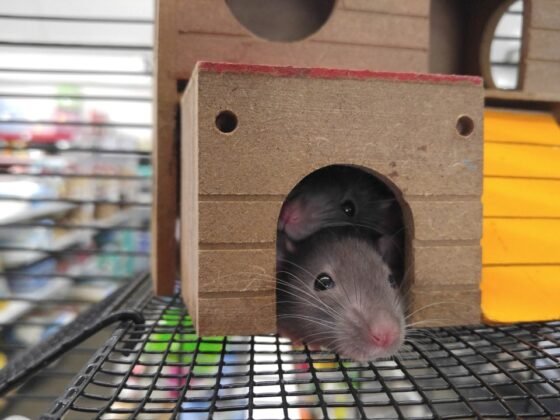Table of Contents Show
You only need two! One male and one female are enough to start a mice infestation. That one pair can produce up to 120 babies every year.
As charming as they are in children’s books and movies, no one purposefully invites mice into their home. If you’ve never seen a mouse in your house, how would you even know you had one (or two or 120)?

Three of your five senses can help you do the detective work to find out if you have a mice problem.
This article identifies the most common clues you have mice living with you. Even if you don’t suspect they’ve moved in, it’s a good idea to know the signs before you end up with a mice problem.
Look for Mouse Droppings
Finding what looks like mouse droppings can upset even the most tranquil person. Before losing your sense of calm, try to identify what you’ve discovered.
Mice can excrete anywhere from 50 to 80 droppings each night. If you find small (less than ¼ inch) black rice-like objects, you likely have mice present.
If you notice droppings in a variety of sizes, it usually indicates the presence of both adult and juvenile mice.
The first place to look for mouse droppings is anywhere you store food. Kitchen cabinets, drawers, and pantries are the most logical areas to check, but you can also find droppings scattered along with countertops and floorboards.
Mice seek warmth. Look for evidence of infestation in utility closets and near appliances like your furnace, stove, and clothes dryer.
Next, check the bathroom cabinets and linen closet. Your last checkpoint should be the attic and crawlspace.
Pest extermination experts at Synergy², recommend a comprehensive inspection of your home if you find mouse droppings or any other signs you have mice.
Do You Smell Ammonia?
If you have or have ever had a cat or dog, you know how territorial they can be, especially the males. Mice behave in much the same way, establishing and marking their territory with urine.
If you smell ammonia, especially in closets, pantries, or drawers, it’s a sign you shouldn’t ignore. Strong ammonia-like odors indicate you’re close to an active mice area.
Be aware that you may still notice a lingering smell for a long time even if you’ve had the mice exterminated.
In addition to the smell of ammonia, you may also discover other unpleasant evidence of mice.
For example, they often leave dark, greasy smears around holes and in corners.
If you have a heavy infestation, you may find urine pillars—mounds created when urine combines with dirt and body oils (from the mice, of course!). Urine pillars can be around two inches tall and half an inch wide.
Read Also:
Mice are Crafty
Since they must build nests to give birth to and raise their young, mice look for anything they can craft into a nursery. In this case, nothing is safe, at least nothing made from fabric or paper.
Here are some common materials mice use in the building process:
- Yarn
- Tissues
- Cotton Balls
- Dryer Lint
- String
- Furniture Stuffing
- Insulation
- Newspaper
- Cardboard
- Your Clothes
If you find clothing with unexplained holes, you may have mice in your home. They love to shred bits of soft fabric to line their nests.
Look for little piles of shredded materials in corners, under cabinets, and anywhere else mice tend to reside.
Notice Small Holes That Do Not Make Sense?
Chewing holes in clothing isn’t enough activity for mice, so they find other areas where they can wreak havoc.
Mice are smart, and they have powerful little teeth that they use to chew holes in the bottoms of drawers and cabinets. They also chew holes in walls and furniture.
Why so many holes? It’s all part of their quest to find new places to build nests and produce more mice.
Mice don’t need to chew new holes to gain access to your home. They’re perfectly happy finding the tiniest hole they can squeeze through to get inside and start building.
Speaking of holes, it’s a given that mice will chew through any cardboard box in your kitchen. They’re not fussy and will get in and eat dried cereal, bread, pasta, oatmeal, and rice. Mice also enjoy dried beans.
Getting rid of mice should always include an inspection of the interior and exterior of your home. Look for gaps around plumbing pipes, and cracks at the bottom of doors and windows.
Listen for Scratching
Mice do their best work at night. That doesn’t mean you’ll never see a mouse during the day, but they have a nocturnal nature, which makes daytime sitings rare.
Out of sight, out of mind, doesn’t work when it comes to mice infestations. You can often hear evidence of their presence. If you hear odd scratching sounds in your walls, it’s likely mice.
They spend their nights searching for food and materials to construct nests.
In addition to their scritch-scratch noises, mice scurry. You may hear soft, scuffling sounds as they brush against walls.
Did you know mice communicate with each other? Mice chatter resembles squeaking. Now, keep in mind, you’ll likely hear them scratching and scurrying before you ever detect their vocalizations.
Mice talk to each other to alert the pack when they find food and shelter. Mating season is another good time to listen for mice squeaking.
Ask Rover and Fluffy
Your pets can alert you to the presence of mice in your home long before you find droppings, hear noises, or notice holes in your clothing. Pay attention to pet behavior whether you suspect a mice problem or not.
Cats and dogs get excited when they hear mice activity.
With their powerful sense of smell, dogs know when a mouse is in the house. You’ll notice them sniffing more diligently than usual. Some breeds, such as terriers, are trained to detect and catch mice.
If you have a cat around the house, you have a natural mice catcher. Cats use their sense of smell, taste, and hunting instincts to help you determine whether you might have a mice problem.
Ready to Watch for Signs You Have Mice?
Even the tiniest suspicion you have mice living in your home should get your immediate attention. Acting quickly can prevent an infestation from taking hold.
We hope you’ve enjoyed reading this article! If you did, come check out the rest of our blog. You’ll find many more posts of interest to any home dweller.










